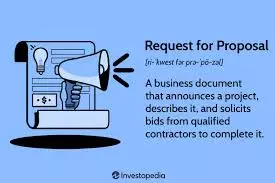A Request for Proposal (RFP) is a significant part of a business’s procurement process that paves the way for streamlining negotiations and narrowing down the list of potential vendors.
If you’re not sure where to start or how to write an effective RFP, don’t worry. Below, we’ll cover all the essentials.
Understanding the Concept of a Request for Proposal
Alt text: A group of employees sitting in a conference room with a nice view of the city outside a big and wide window.
A Request for Proposal is a document issued by a business when it seeks to procure a service or a product and invites potential suppliers to submit a proposal.
It outlines the project’s specifics, scope, and what the company expects from the bidder. The RFP usually includes the project’s constraints, budget, timeframe, and key deliverables.
In simple terms, an RFP serves as the business’s wish list for the project. It provides a detailed description of the project’s requirements and sets the proposal uation criteria.
To get a more comprehensive understanding, you can review an in-depth request for proposal meaning.
A well-written RFP benefits both the issuer and the bidder. It simplifies the vendor selection process for the issuer by providing a mechanism for comparing different proposals on a level playing field. For the bidder, it gives clear guidance on what is expected, reducing the risk of misunderstandings later.
The Crucial Components Necessary for a Comprehensive Request for Proposal
Although the structure of an RFP can understandably vary depending on the project and the company, the following components should be included in all cases: a project overview, project requirements, timeline and milestones, budget indications, proposal submission process, and uation criteria.
The project overview provides the potential vendors with the context of why the project is being initiated, what problem it aims to solve, and the expected outcome.
The timeline and milestones section gives vendors an idea of when the company expects the project to start and end and when important milestones are scheduled.
The budget indication helps vendors understand the financial expectations, whereas the uation criteria guide them on what will take precedence when the company uates the bidder’s proposal.
How to Write an Effective Request for a Proposal
First, define your project clearly. Understand your objectives and needs, identify the problem you are trying to solve, and outline what success looks like for this project.
Secondly, gather all necessary information about your project. This includes the scope of work, business requirements, key performance indicators, and project timeline.
Next, write the RFP. This involves detailing all the sections mentioned in the previous heading. Remember, clarity is key here. Ambiguity can lead to misinterpretation, which can lead to ineffective proposals.
Common Mistakes to Avoid When Crafting a Request for Proposal
A common mistake companies sometimes make when writing an RFP is failing to communicate their needs properly.
This can lead to misinterpretations, which can result in unmatched solutions. Make sure your needs, standards, and expectations are all communicated clearly in your RFP.
Another common mistake is overloading your RFP with unnecessary information. Too much information can confuse vendors and make the RFP difficult to read. So, ensure your RFP is concise, clear, and concise.
Lastly, avoid being hasty in your vendor selection. Give adequate time to potential vendors to understand your project fully and respond adequately.
Benefits of a Well-Written Request for Proposal for Businesses
Alt text: A group of business people gathered around a conference table while on their laptops and writing on different documents.
A well-written RFP helps identify the right partner for your project. It makes it easy to compare vendors on their capabilities, service offerings, and prices, leading to a more informed decision.
RFPs also help in driving competition among vendors. When vendors know they are up against each other, they will likely offer competitive pricing and add innovative solutions to stand out.
Lastly, a well-crafted RFP can also help reduce the risk of project failure. Since it sets clear objectives, expectations, and deliverables right at the beginning, it minimizes misunderstanding and mismatched expectations.

